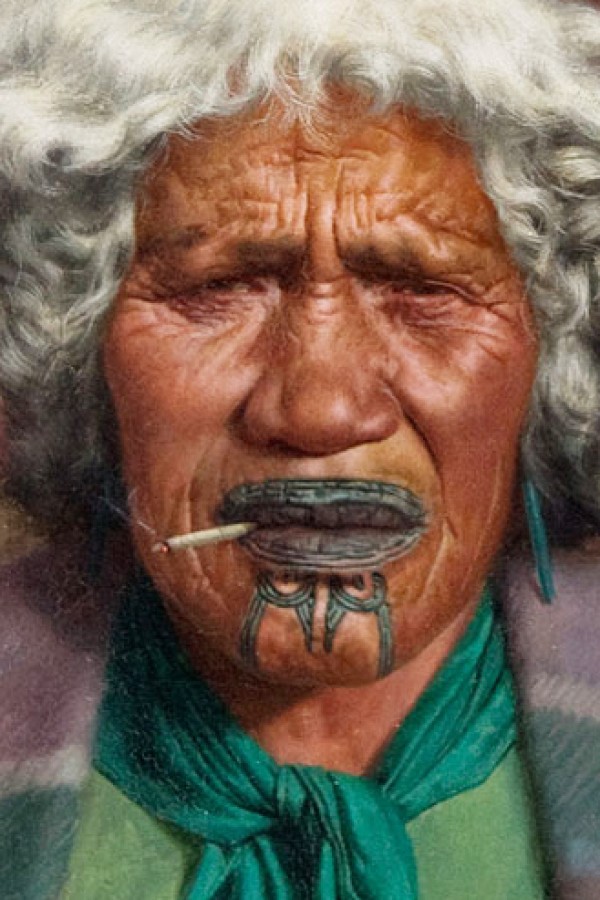What emotions is this person feeling?

No Koora te Cigaretti,
1915
-
Bright emotions
-
Not at all Extremely
-
-
Quiet emotions
-
Not at all Extremely
-
-
Heavy emotions
-
Not at all Extremely
-
-
Sombre emotions
-
Not at all Extremely
-
Compare yourself to others
Choose different variables below, and see the patterns of response reflected in the circle of emotion above. Your responses are the coloured wedges. Others' responses are averaged in the spider graph of lines and dots.

Date: 1915
Creator of the image: Charles Frederick Goldie Date of the image creation: 1915 Medium of the image: Oil on canvas Person depicted: Mihipeka Wairama Michael Dunn describes Goldie’s painting beautifully. It is quoted here at length: ‘Mihipeka Wairama was a favourite model for Goldie between 1912 and 1915 when he was at the peak of his powers as a portraitist of old-time Maori. Her striking facial features, heavily lined but still handsome, her wonderful chin moko and her splendid head of hair made her an irresistible subject for him. Her colourful history as a survivor of the Tarawera eruption linked her to the Buried Village of Te Wairoa and the tragic events there in 1886 when the Pink and White Terraces were destroyed. When he met her in 1908 at Whakarewarewa, she was living with other Tuhourangi people near Rotorua, displaced from her ancestral home and dependent for a living on the tourist trade. Now a mature woman, a kuia, with stories to tell of her early life and its tragic beginnings, she was willing to sit for Goldie no doubt for a small fee. He painted two versions of No Koora Te Cigaretti, the earlier dated 1912 and now in Adelaide, and the present example dated 1915. Their compositions are almost the same but the Adelaide version is unfinished in the corners of the canvas and may have been intended to be presented in an oval frame. He also painted another fine portrait of her in near profile, dated 1912 (private collection) without the cigarette. All three paintings show her in head-and-shoulders format set close to the picture frame and dressed in a woven blanket draped over a blouse with a scarf around her neck.’ ‘The present work shows her facial features full frontal in sharp, meticulous detail. Her ear pendant of greenstone is painted with great care to bring out its hard, shiny surface and contrast it with her softer, textured skin. Conveying the tactile qualities of the subject matter and the contrasts between skin, hair, blanket and moko are critical to Goldie’s mission as a painter. In accordance with his French academic training, he wants to make her appear real and for the work to be a fully finished study, accurate in every detail. Everything is resolved, nothing left to chance. There is also careful attention to lighting and modelling of the features. He uses a pronounced chiaroscuro that casts her right cheek and shoulder into shadow where detail is reduced, but where, too, the white of the cigarette stands out against the shadowy skin behind it. Each touch of paint is placed carefully with the virtuosity of a master in command of his craft.’ The title No Koora Te Cigaretti draws attention to her smoking and introduces an element of controversy. Loosely translated, it means ‘cigarettes are no good’ in the sense that she would prefer something stronger, namely tobacco in a pipe. The habit of smoking like that of drinking alcohol was introduced to Maori by the European settlers much to their disadvantage when they became addicted. Both men and women indulged at a time when it was rare for middle-class European women to smoke or drink heavily. Goldie seems to see some humour in her addiction though the portrait is sympathetic rather than judgmental and her dignity is preserved. She is shown at a time of change when traditional Maori life and customs were threatened by European values and adjustments had to be made. Goldie was well aware that he was recording a vanishing way of life and tended to dwell on the nostalgic aspects of his subjects. This explains the reflective nature of Mihipeka’s expression with eyes half closed as if thinking about times past rather than about the present.’